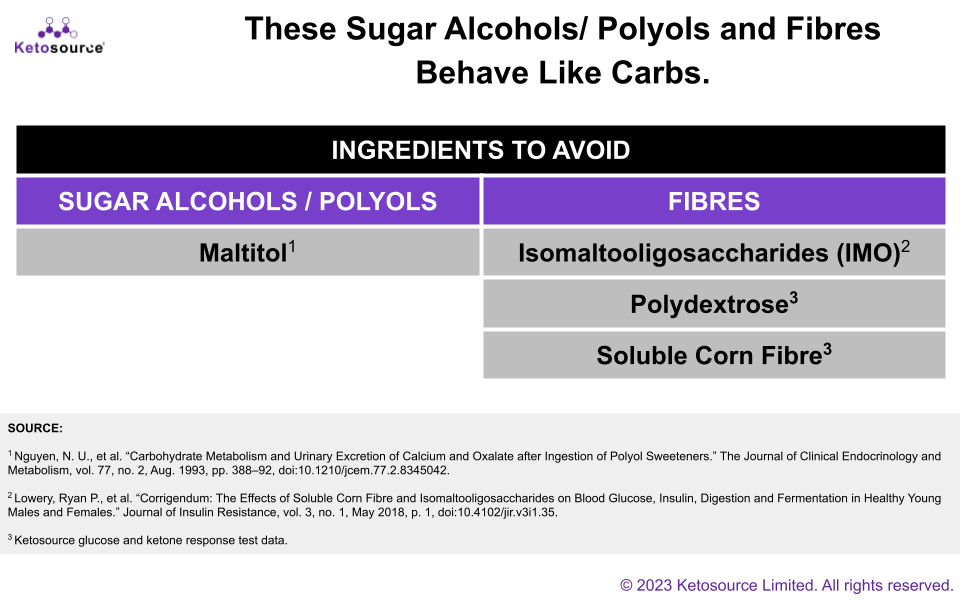ONE Actionable Takeaway from Ketosource
Does counting the grams of carbs on food or drink packaging always work? Unfortunately, not.
But, with the information below you can avoid most issues.
When there are hidden carbs in the ingredients they don’t get counted as carbs on the product’s nutrition table.
So unless you check the ingredients and know what to look for, you are going to get an increase in glucose that you weren’t expecting.

ONE Quote from a Credible Expert
Why electrolytes are important when starting a ketogenic diet from Dr. Dominic D’Agostino, professor professor and scientist founder of a laboratory at IHMC researching ketogenic diets:
“So when we go on a ketogenic diet, you suppress the hormone insulin, and that has a diuretic effect, but it also has a natriuretic effect.
A natriuretic effect means that your body dumps a lot of sodium. And with sodium, your fluid levels will drop and you will become hypovolemic.
So your, the plasma, there’ll be a contraction of the plasma volume, and that will decrease brain blood flow… you can get a headache… you get orthostatic hypotension and things like that.
So it’s really important to increase your sodium, to increase your electrolytes and increase your fluid when you initiate a ketogenic diet. And that can mitigate many of the side effects.”
ONE of Your #1 Questions Answered
The Question:
The top question sent in from you this week was from Matt Knowles. Thank you Matt!
“I would like to hear the science on getting back into keto. Not for the first time ever but after having been in it for many years. But taking a break over Christmas and eating all those [non-keto] things. Is it quicker the second time to enter? Any tips for a smooth quick transition?”
The Answer:
I have not seen any scientific studies on re-entering ketosis after coming off a ketogenic diet. So I can’t say definitively if your experience will differ for re-entry compared to when you first started the ketogenic diet. But, based on client experience, it’s a reasonable assumption to say re-entry is similar to starting a ketogenic diet for many.
The takeaway is this – the most important thing for starting or re-entry is to prevent negative symptoms from keto induction. Keto induction is the technical term for what people call informally ‘keto flu’. Symptoms can include headache, fatigue, cramps, and constipation.
We can leverage two mechanisms to avoid these symptoms:
1. Increase electrolyte intake to compensate for electrolyte loss and deficiency.
2. Reduce your time to ketosis/ time out of ketosis.
1. Electrolytes
Electrolytes have the most evidence on reducing negative symptoms. So this is the most important. We recommend you increase your electrolyte intake to cover potential deficiencies.
Our client experience has shown that we need to personalise electrolyte intake for it to be effective. So I can’t just give you a list of pills or an electrolyte product to take. Also, overdosing electrolytes can be as problematic as deficiencies – so we need to get it right.
So the solution we found at Ketosource was to build a personal electrolyte calculator.
Here’s how it works:
- You answer a few questions that allow us to identify your electrolyte situation
- It runs some backend calculations using our algorithms
- It emails you a report with your calculated electrolyte deficiency and the best way to cover it
Access the Ketosource electrolyte calculator here.
2. Time to Ketosis
Studies show keto induction (time to ketosis) takes at least 3 days after removing carbs. Based on the available research and our personal experiences at Ketosource, reducing your time to ketosis will help remove or reduce symptoms.
There are two approaches you can take for this:
- Bridge the keto induction days: You can take a ketone boosting supplement like my Pure C8 MCT Oil or exogenous ketones like BHB Ketone Salts.
- Shorten the keto induction days period: You can deplete your glycogen stores quicker through exercise (or even fasting). The mechanism works like this. Your body won’t make ketones until your glycogen stores are removed. So you can exercise or fast or do both to speed up the glycogen depletion process.
In Summary
- Use the personal electrolyte calculator to find your best electrolytes supplementation approach.
- Reduce time to ketosis by boosting your ketones (Pure C8 MCT Oil, BHB Ketone Salts) to bridge the period or by depleting your glycogen by exercising or fasting to reduce time to ketone production.
SPECIAL: Continuous Ketone Monitor Experiment – You Decide What to Test
I’m guinea-pigging myself in a continuous ketone monitor self-experiment.
I have a research device that tracks ketones 24-hours a day via a sensor (similar to the DEXCOM for continuous glucose monitoring (CGM), but for Ketones).
What would you like me to do while wearing this for 14 days?
I’m crowd-sourcing this. So you vote. You decide. Then I do it during those 14 days. And report back the results to you.
To vote on what you want me to do click here.